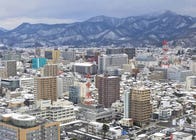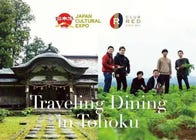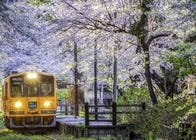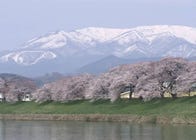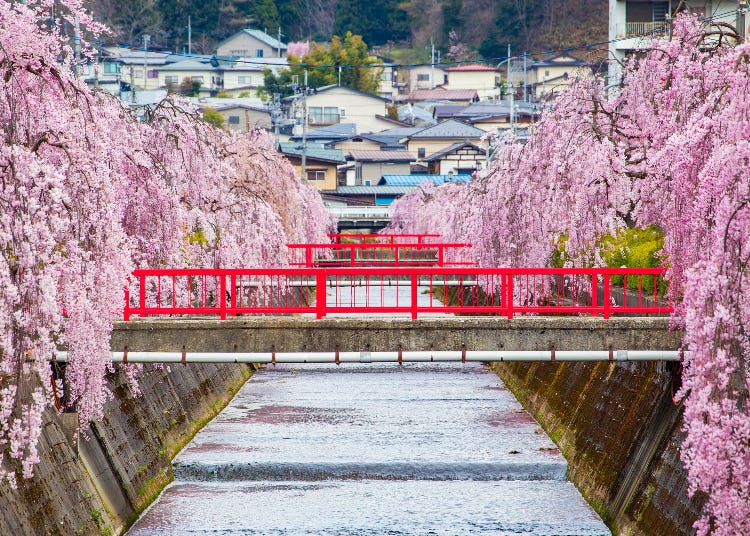
Tired of fighting the crowds during the peak cherry blossom season? Take a step off the beaten path and head up to the Tohoku Region, where the natural wonders and cherry blossoms of Yamagata Prefecture are just waiting to be explored.
(Main image: PIXTA)
Getting to Yamagata
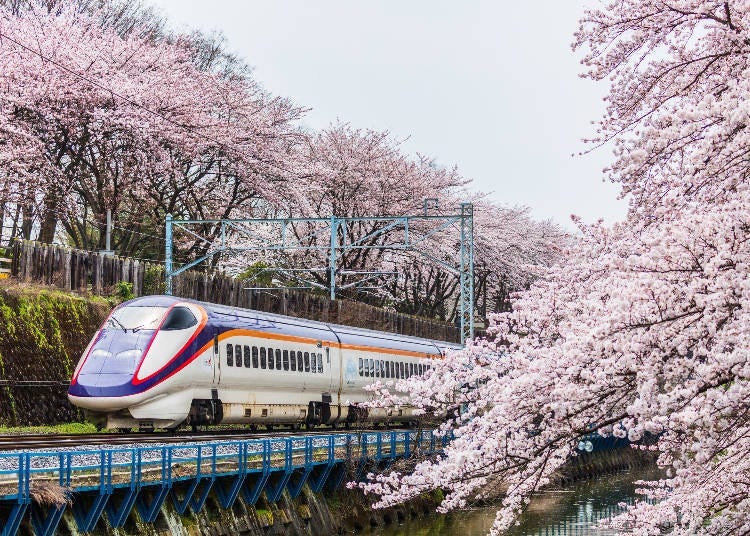
One thing to note is that Yamagata has two main geographic regions: the Shonai Region and Inland Yamagata. These two regions are pretty far in distance and have different travel routes, so plan accordingly.
By rail: Yamagata City is easily accessible via the JR Yamagata Shinkansen "Tsubasa" from JR Tokyo Station (2.5-3 hours), covered by the JR East Tohoku Area Pass, the JR East-South Hokkaido Pass, and the Japan Rail Pass. Yamagata Station serves as a central hub for many destinations mentioned in this article.
By air: The quickest route to the Shonai region is by air from Tokyo Haneda Airport to Shonai Airport (SYO) (1 hour), followed by a bus transfer to Tsuruoka (1 hour) or Sakata (30 minutes). Yamagata Airport (GAJ) and Sendai International Airport (SDX) are also nearby options, depending on where you are coming from. (See here to book domestic flights.)
By rail (Shonai Region): Take the JR Joetsu Shinkansen from JR Tokyo Station to JR Niigata Station (2 hours) and then a limited express train from Niigata to Tsuruoka or Sakata (2 hours). This route is covered by the Japan Rail Pass and the JR East Nagano Niigata Area Pass. (See here for directions from Tokyo Station.)
Getting Around Yamagata
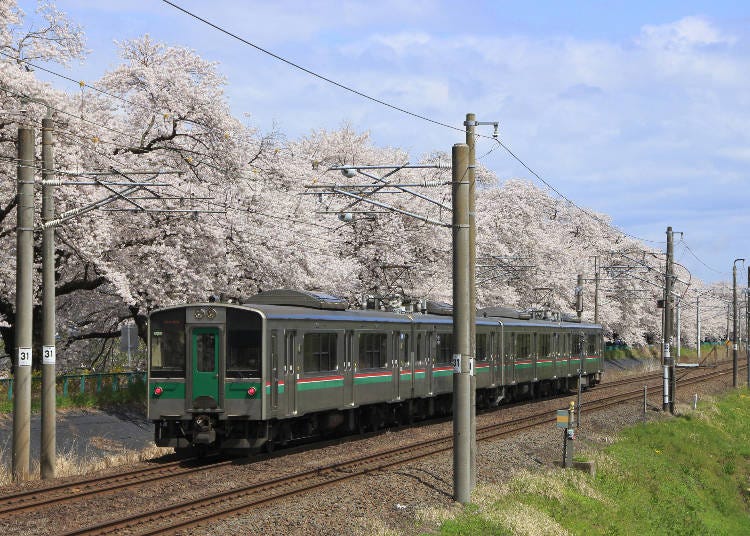
While most areas in Yamagata are accessible by train or bus, many visitors opt to rent a car upon arrival in the prefecture for convenience and quicker access. Most trains and buses only come at most once per hour, so plan your route with this in mind.
When is Cherry Blossom Season in Yamagata?
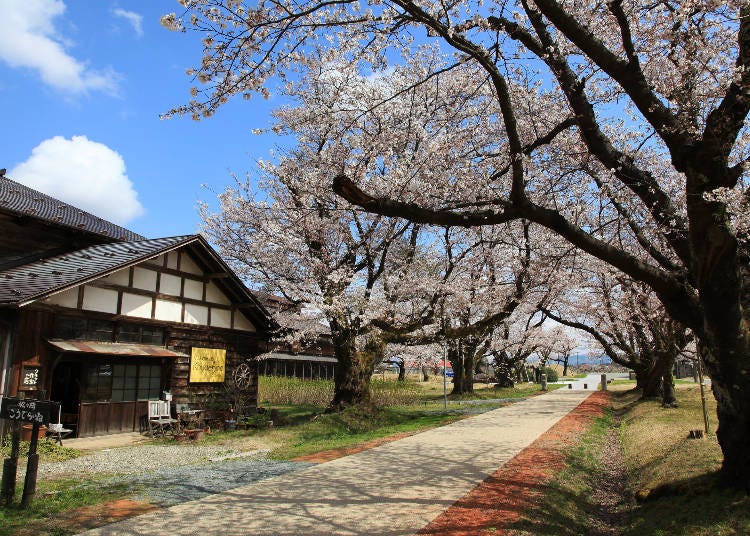
Being located in the northern part of the country, the cherry blossom season in Yamagata starts much later than in Tokyo, Kyoto, and Osaka. In 2024, the cherry blossoms are expected to start around April 6th and then reach full bloom close to April 11.
Due to Yamagata's mountainous nature, however, many areas at high elevations, such as Zao and Hijiori Onsen, will have a slightly later cherry blossom season due to cooler mountain temperatures.
Of course, as with anywhere in Japan, these dates can vary from year to year due to the weather.
The best places in Yamagata to see cherry blossoms
Yamagata is known for its pristine nature and unique topography that has even inspired writers, poets, and artists for centuries. In addition to being some of the most unique places in Japan to catch a peak of pink, the following list of places is more than worth making the trip out to Yamagata, each on their own, as you’ll never find anything like them anywhere else!
1. Kajo Park (Yamagata City)
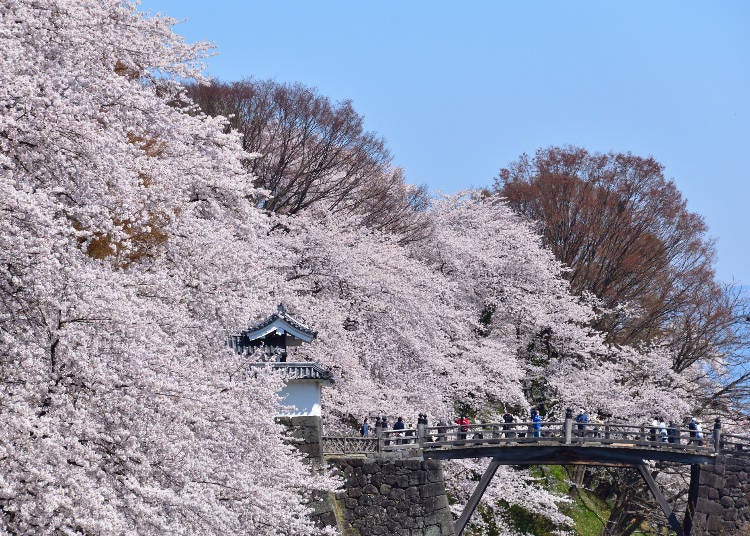
Kajo Park in the spring is a picturesque oasis located right at the heart of Yamagata City and is one of the most popular cherry blossom viewing spots not just in Yamagata but in the entire Tohoku Region.
Kajo Park sits upon the ruins of Yamagata Castle, which stood as a formidable stronghold belonging to the Mogami clan as early as the 14th century. However, under the leadership of Yoshiaki Mogami, during the 16th century, the castle played a pivotal role in shaping Yamagata's development during Japan's feudal era. It led to the prosperity of Yamagata City as a seat of power in the region.
Post-Meiji Restoration, however, Japan did away with castles as they shifted to a Western-style government. In 1878, the castle was deconstructed, and Kajo Park was erected in its place. Today, the second and innermost walls of the castle remain and are accentuated by over 1,500 cherry blossom trees that line the park. Catching a photo of the local train zooming by with the cherry blossoms and castle wall in the background is all but a right of passage, and fallen petals in the moat are a sight for sore eyes.
The park also hosts several cultural attractions, such as the Mogami Yoshiaki Historical Museum, the Yamagata Prefectural Museum, the Yamagata Art Museum, and the Old Saiseikan Hospital Building, which highlight can keep you entranced here for hours.
-
Kajo Park霞城公園
- Address 1-7 Kajomachi, Yamagata, 990-0826
2. Tsuruoka Park (Tsuruoka City)
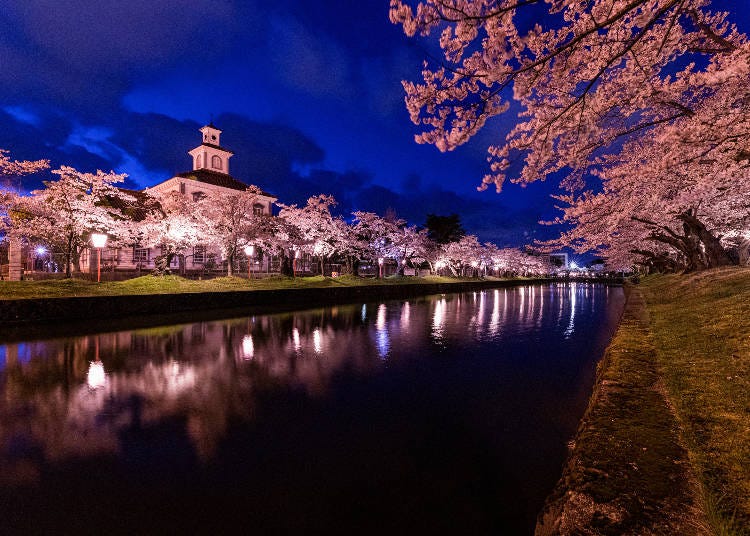
Tsuruoka Park is right in the center of Tsuruoka City and is a beloved destination renowned for its rich history and stunning natural beauty. Originally established in 1938, the park encompasses an area of lush greenery, serene ponds, and meticulously manicured gardens, offering visitors a quiet escape to walk the dog, jog, or just take a stroll.
That is unless it is cherry blossom season, as Tsuruoka Park is revered as one of the 100 most beautiful cherry blossoms sightseeing spots in Japan, making it a hotspot in the spring for hanami enthusiasts who all want to catch sight of the ephemeral plumes of pink and white.
Tsuruoka Park holds deep cultural significance, and it found its origins in the Edo period when it served as the grounds of the former Tsuruoka Castle. Just like Kajo Castle, the castle was ordered to be repurposed after the Meiji Restoration, however, today, Shonai Shrine still proudly stands at the park to remind us of the history and legacy that this park carries.
-
Tsuruoka Park鶴岡公園
- Address 4 Babacho, Tsuruoka, Yamagata 997-0035
3. Tendo Park (Tendo City)
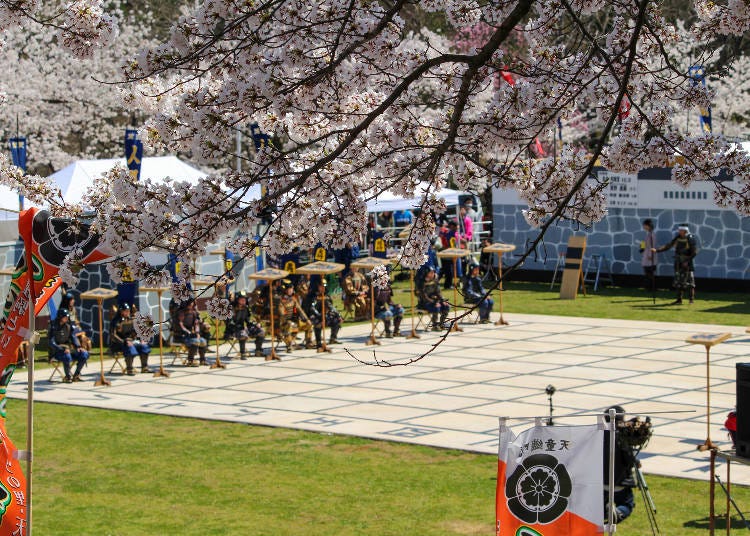
Shogi is a traditional game with a long history in Japan and is often even referred to as “Japanese chess.” While the city of Tendo may be relatively unknown to most travelers, chances are that if you’ve ever played shogi, you’ve already held a piece of Tendo as 90% of Japan’s shogi tiles are made here in Tendo.
While the Cherry Blossom Festival in Tendo is stretched across the entire month of April, the real reason to visit Tendo in the spring is the Ningen Shogi Festival (Human Shogi Festival), which takes place over a single weekend in April. During the festival, spectators flock to Tendo Park to witness the spectacle unfold on a life-sized shogi board measuring 16 meters by 14 meters. Attendees are immersed in the ambiance of wartime Japan as they observe the human shogi "pieces" adorned in traditional kimonos and warrior armor. Guided by professional shogi players, 40 volunteers, often comprising locals and high school students, maneuver across the board, mirroring the strategic gameplay of the ancient game.
-
Tendo Park天童公園
- Address 4146 Tendo, Tendō, Yamagata 994-0000
4. Kaminoyama Castle (Kaminoyama)
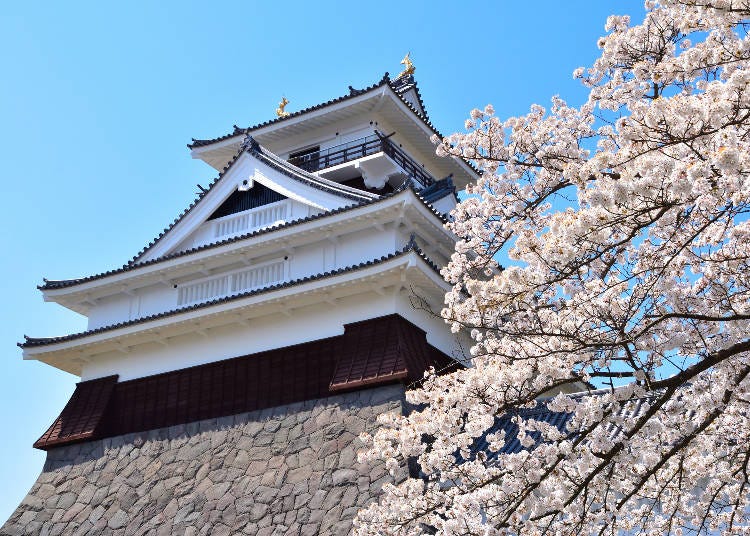
While the onsen town of Kaminoyama is more than worth the stay in any one of its quaint ryokans, visiting the castle on a day trip from Yamagata City is a great way to make the most of the season and see some striking cherry blossoms.
Originally constructed in 1535, Kaminoyama Castle played a crucial role in the region's defense and governance as Kaminoyama was strategically located along the Ushu Kaido, a road connecting the historic capital of Edo and the northern provinces. The present-day structure we see today, however, is a reconstruction completed in 1982, meticulously crafted to replicate the splendor of the original, and is the only standing castle in Yamagata Prefecture.
Nestled atop a hill, the castle offers panoramic views of the surrounding landscape that comes alive during the cherry blossom season. Visitors can explore the castle grounds, which feature a museum showcasing artifacts and exhibits related to its storied past. Adjacent to the castle is a free foot hotspring that can be best enjoyed under a canopy of sakura on a sunny spring day.
-
Kaminoyama-jo Castle Ruins上山城郷土資料館
- Address 3-7 Motojonai, Kaminoyama, Yamagata 999-3154
5. Eboshiyama Park (Akayu)
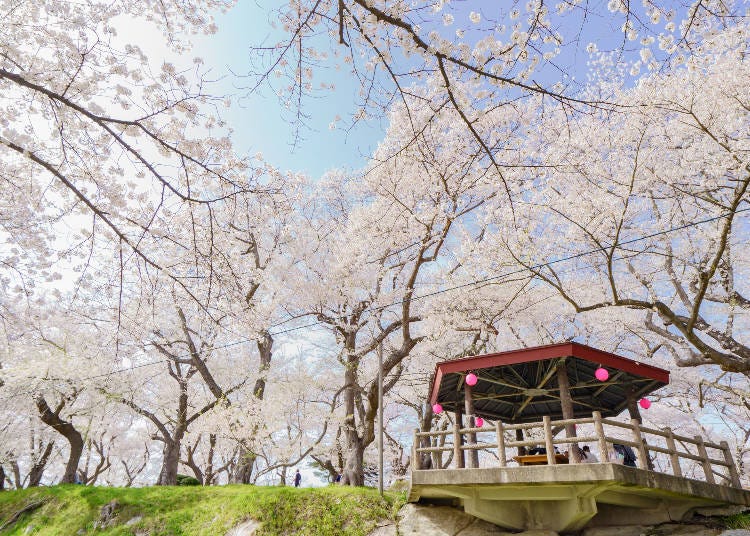
Perched up on a serene plateau with sweeping vistas of Yonezawa, Eboshiyama Park was constructed with care and dedication by local residents over the span of three decades from 1878 to 1910. The love and passion of the community is particularly felt in this enchanting park during the spring when a breathtaking array of approximately 1,000 sakura trees come to life, including the iconic Somei-Yoshino, edohigan, and shidarezakura varieties. As twilight descends, the park transforms into a magical wonderland, with the sakura trees illuminated, casting a soft glow that mesmerizes visitors.
Adjacent to the park lies the magnificent Eboshiyama Hachimangu Shrine, home to Japan's largest stone torii gate, is framed by majestic shidarezakura trees and makes for the perfect picture to encapsulate your memories of springtime in Yamagata.
For the ultimate indulgence, visitors can immerse themselves in the nearby Akayu hot springs, where they can luxuriate in the soothing waters while basking in the otherworldly beauty of the sakura blossoms.
-
Eboshiyama Park烏帽子山公園
- Address 1415 Akayu, Nanyō, Yamagata 999-2211
6. Matsugasaki Park
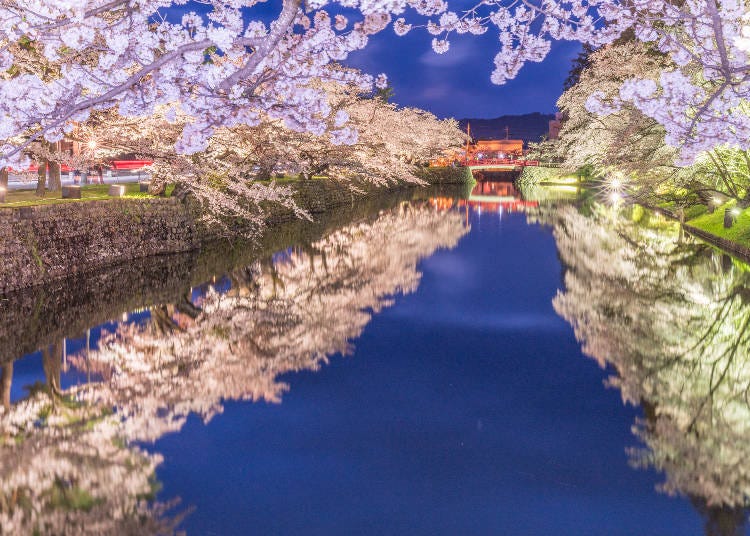
Located within the grounds of the former Yonezawa Castle, Matsugasaki Park exudes a serene charm, juxtaposing the turbulent history of the castle during the Waring States period. The park's tranquil atmosphere is accentuated by the water-filled moats, remnants of the castle's past, which now offer a peaceful respite for visitors. History enthusiasts are drawn to the park's numerous sites associated with the formidable Uesugi clan, including renowned warriors like Kenshin Uesugi and Yozan Uesugi, known for his inspirational saying, "Where there is a will, there is a way."
Notable historical attractions within the park include the revered Uesugi Jinja Shrine, believed to bring good fortune and fulfill wishes, and the treasure hall Keishoden, showcasing a collection of Important Cultural Properties related to the Uesugi clan. Additionally, a stone monument marks the birthplace of Masamune Date, the legendary feudal lord known as Dokuganryu (One-Eyed Dragon).
Matsugasaki Park is particularly popular in spring, when over 200 cherry blossom trees adorn the moats with their delicate pink blossoms, creating a picturesque scene enhanced by the reflection of the flowers on the water and the traditional red bridges spanning the moats. Visitors flock to the park from mid to late April to witness this stunning display, and nearby attractions complement the park experience, such as the Yonezawa City Uesugi Museum, a venue for learning about the culture and history of the Okitama Region.
-
Matsugasaki Park松が岬公園
- Address 1 Chome-4-13 Marunouchi, Yonezawa, Yamagata 992-0052
7. Yamagata Railway Flower Nagai Line (Nanyo-Shirataka)
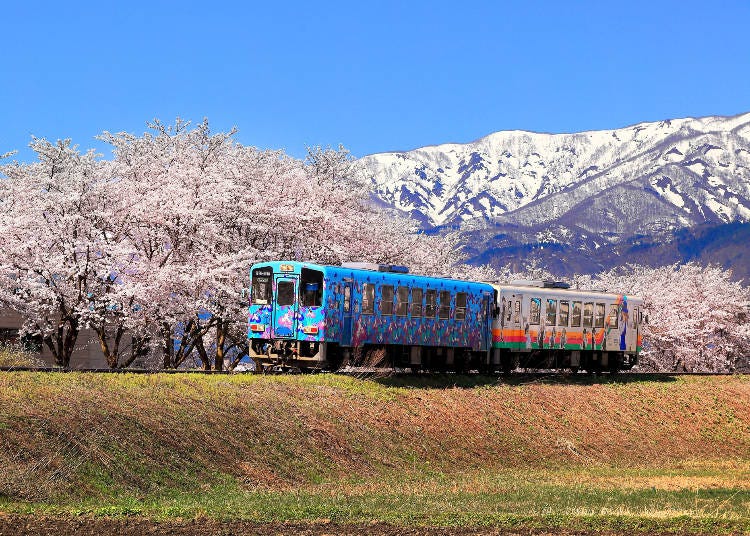
Spanning approximately 30.5 kilometers through southern Yamagata Prefecture, this local line offers passengers a scenic journey amidst the region's natural splendor. As the train traverses the countryside, travelers are treated to sweeping views of expansive rice fields and distant mountain ranges stretching as far as the eye can see.
Aptly named the "Flower Nagai Line," this railway is renowned for the array of picturesque spots adorned with vibrant flowers along its route. From irises to dahlias, lilies to roses, and even classical cherry blossom trees that have graced the landscape for over a millennium, passengers are immersed in a kaleidoscope of colors throughout their journey. Particularly enchanting is the stretch between Nagai Station and Arato Station, where the absence of private residences along the tracks allows for uninterrupted vistas of rural scenery woven together by the patchwork of rice fields and towering mountains. Popular among locals and tourists alike, this route offers a quintessential Japanese landscape experience, showcasing breathtaking snow-covered vistas in winter and enchanting cherry blossom displays in spring.
-
Akayu Station赤湯駅
- Address 863 Wakasa Goya, Nanyo-shi, Yamagata 999-2262
8. Mogami Park (Shinjo City)
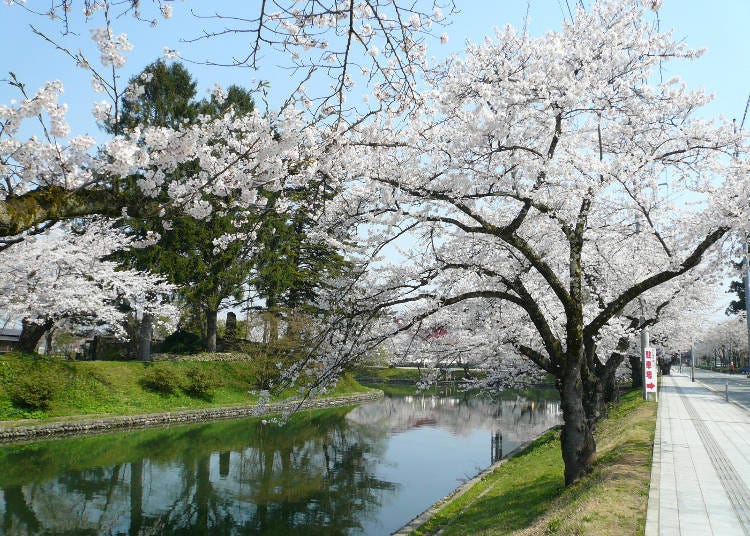
Shinjo City is the last stop on the Yamagata Shinakansen Line, but yet beckons visitors to Mogami Park each year with its enchanting display of approximately 350 Somei-Yoshino and shidarezakura cherry blossom trees, many of which gracefully line the moat surrounding the remnants of the castle.
The park surrounding the Shinjo Castle ruins holds historical significance as it was initially constructed in 1625 by Masamori Tozawa, the esteemed founder of the Shinjo clan. Shinjo Castle, characterized by its flat structure, was encircled by a triple moat, symbolizing its strategic importance during its heyday. Over the course of approximately 243 years and spanning 11 generations, the Tozawa clan presided over this formidable stronghold, leaving an indelible mark on the region's history and culture.
The park springs to life during sakura season, hosting two vibrant festivals: the Shinjo Spring Festival and the Kadoyaki Festival. During this time, locals and visitors alike gather to celebrate the blooming sakura and the arrival of spring. The Kadoyaki Festival holds particular significance, as "kado" is the Ainu word for herring, which return every year to lay their eggs in spring. A cherished local tradition involves indulging in grilled herring laden with eggs, symbolizing the bountiful harvest and the renewal of life amidst the picturesque backdrop of the cherry blossoms.
-
Mogami Park最上公園
- Address 6-86 Horibatamachi, Shinjō, Yamagata 996-0085
9. Mahoroba Green Line (Takahata)
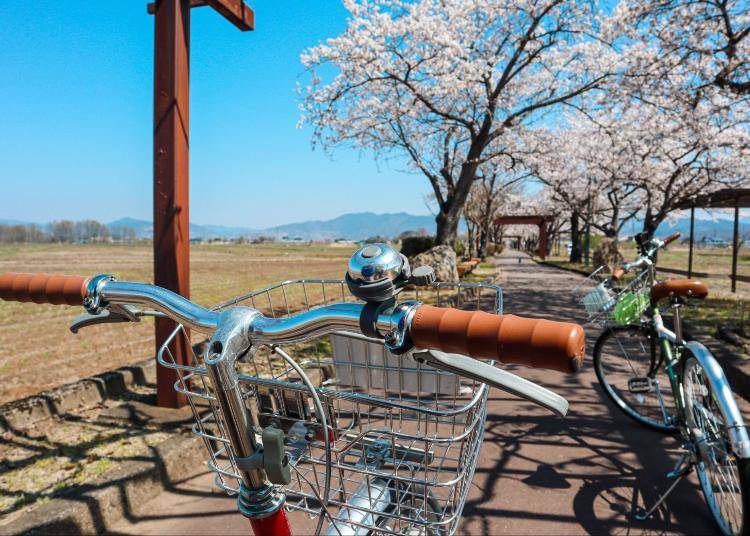
Did you know that Yamagata Prefecture is said to have some of the cleanest air in all of Japan? Take advantage of the natural splendor by getting out and exploring the local charm in the town of Takahata by bike on the Mahoroba Green Line.
Named after the ancient Japanese term "Mahoroba," which evokes a sense of tranquil paradise, and translated as “Arcadia,” this bike path lives up to its name by providing travelers with breathtaking views of verdant forests, majestic mountains and idyllic rural villages along its route. As the path winds its way through the countryside, cyclists are treated to vistas of lush greenery, vibrant flower fields, and tunnels of cherry blossoms, creating an immersive experience that captivates the senses.
Want to learn more about the rich history of Takahata and more about rural Yamagata life? Sign up for a bike tour led by a local guide who will take you through this timeless paradise.
-
Mahoroba Green Lineまほろばの緑道
- Address Yamazaki, Takahata-cho, Higashioki-gun, Yamagata
10. Kuratsu River Weeping Cherry Trees (Tendo City)
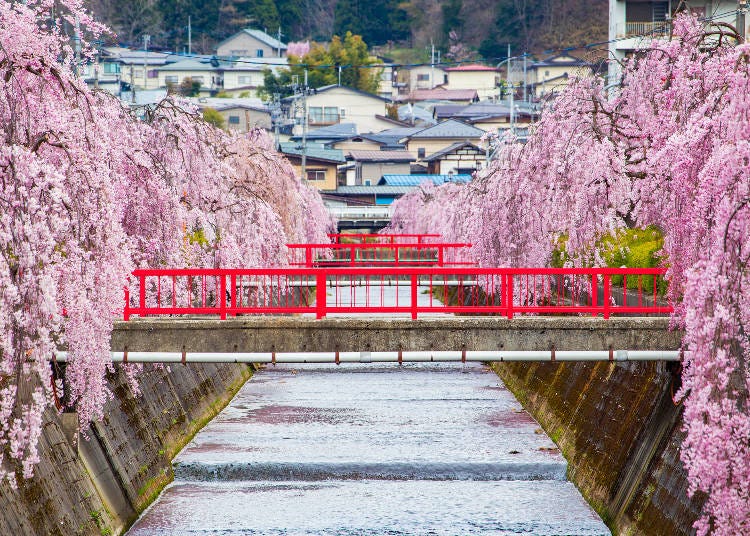
Imagine yourself walking along the bank of a calm river at night, hand-in-hand with that special someone, as illuminated tufts of cherry blossoms bring the dark night sky to life. What could be more romantic than that?
Situated in Tendo City, Yamagata Prefecture, the Kuratsu River weeping cherry trees are celebrated for their stunning romantic ambiance as they wind along a picturesque 1.4-kilometer expanse on both banks of the Kuratsu River. These weeping cherries lend a unique charm to the landscape and are distinguished by their elegant drooping branches. Blossoming from late April to early-May, visitors can enjoy the unreal spectacle both day and night, as approximately 750 meters of the riverbanks are illuminated during the blooming season.
To commemorate this natural marvel, a lively cherry blossom festival is held annually at the end of April, featuring vendor stalls offering local delights and cultural performances. The Kuratsu River weeping cherry trees stand as a testament to the timeless allure of nature, inviting visitors to revel in the splendor of sakura season amidst the scenic beauty of Tendo City.
-
Kuratsugawa Ryokuchi Park倉津川緑地
- Address 2 Izumi-cho, Tendo-shi, Yamagata 994-0013
What makes Yamagata’s Cherry Blossoms so special?
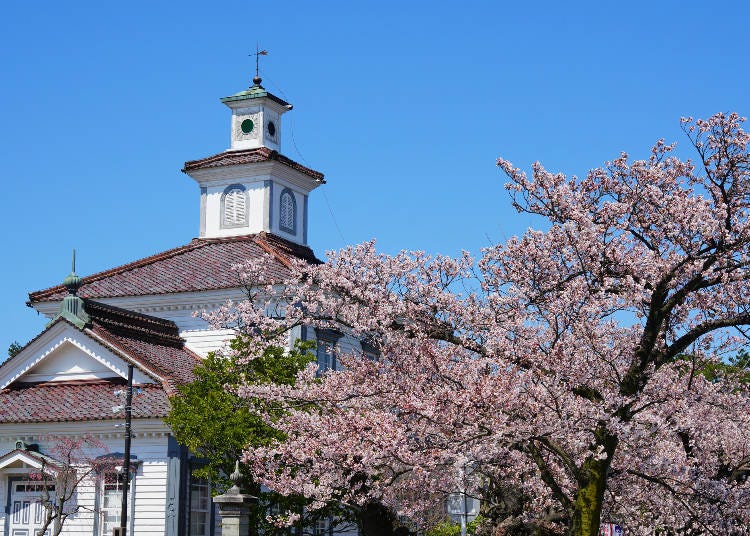
When it comes to tall skyscrapers, bustling crosswalks, and districts of neon signs, Yamagata cannot compete with the likes of Tokyo, Kyoto, and Osaka. But when it comes to the outdoors, serenity, and a culture that has lived in harmony with nature for centuries, Yamagata is one step above the rest. Here in Yamagata, cherry blossoms are not just the backdrop of a picture but a living, breathing part of the history, tradition, and local culture, and that is what makes visiting Yamagata during the cherry blossom season so incredibly special.
Written by:
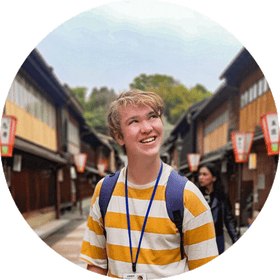
- Area
- Category
*Prices and options mentioned are subject to change.
*Unless stated otherwise, all prices include tax.
Limited time offer: 10% discount coupons available now!
Recommended places for you
-
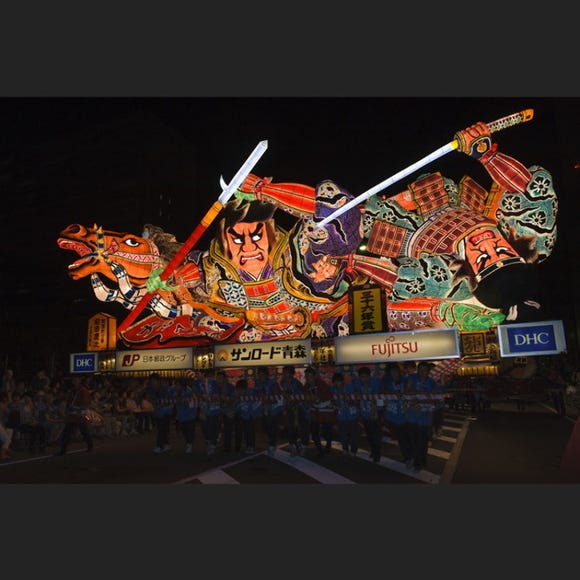
Aomori Nebuta Festival
Japanese Festivals (Matsuri)
Aomori, Hirosaki And Hachinohe
-
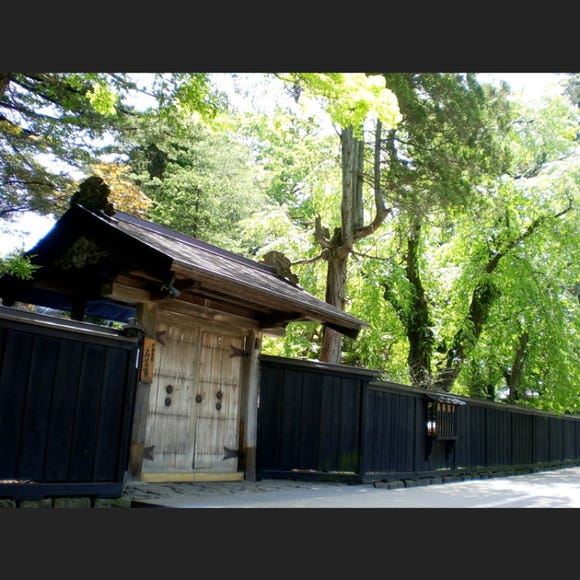
Ishiguro Samurai House
Historical Places
Surrounding Areas Of Akita
-
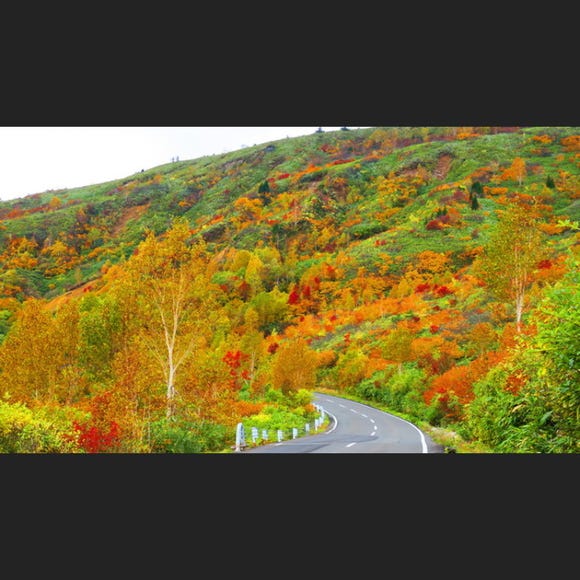
Hachimantai Aspite Line
Landscapes
Morioka, Hiraizumi And Hachimantai
-
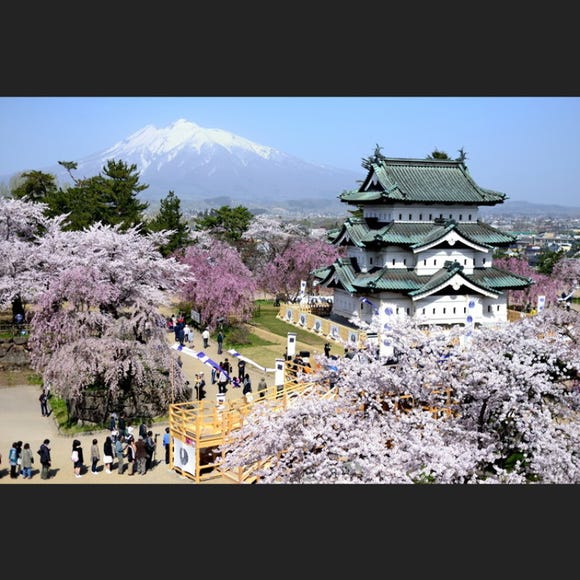
Hirosaki Park
Parks
Aomori, Hirosaki And Hachinohe
-
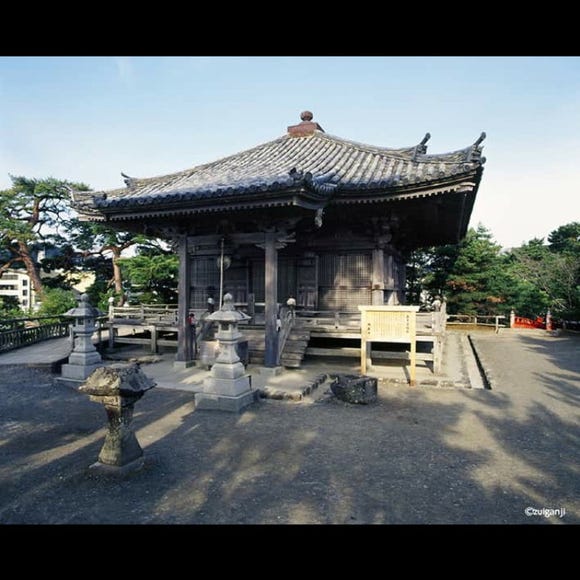
Zuiganji Temple
Temples
Sendai And Matsushima
-
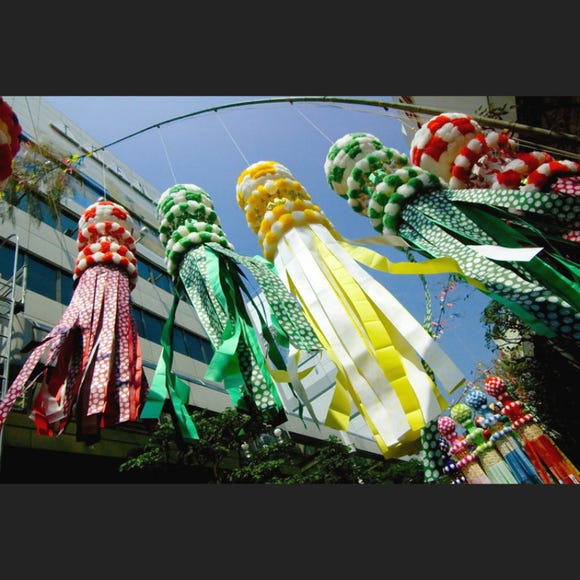
Sendai Tanabata Festival
Japanese Festivals (Matsuri)
Sendai And Matsushima
-
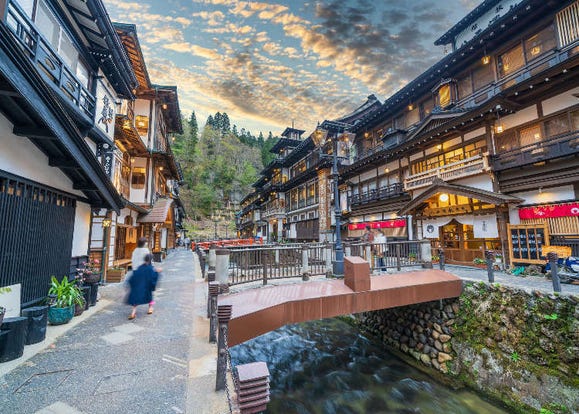
Dreamy Japan: 5 Scenic Onsen Towns in Yamagata Prefecture
-
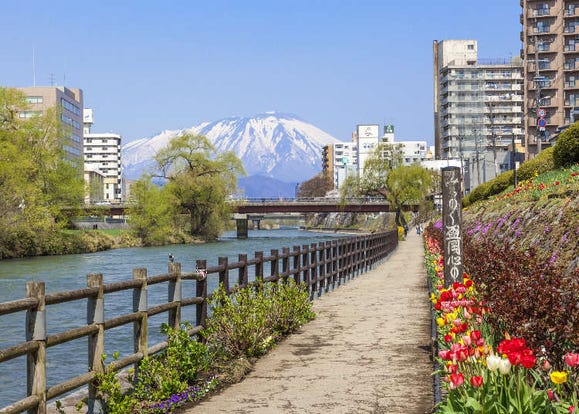
19 Best Things to Do in Morioka: See, Eat, and Shop Your Way Through Iwate's Capital City
-

Explore Tohoku in Winter With 5 Budget-Friendly Travel Passes (Local Recommended!)
-

The Snow Monsters of Zao: Journey Among Yamagata’s Winter Wonders
-
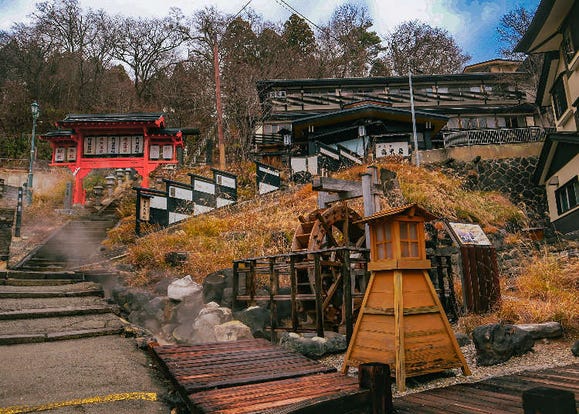
Plan Your Visit to Zao Onsen (Yamagata) - A Comprehensive Guide
-
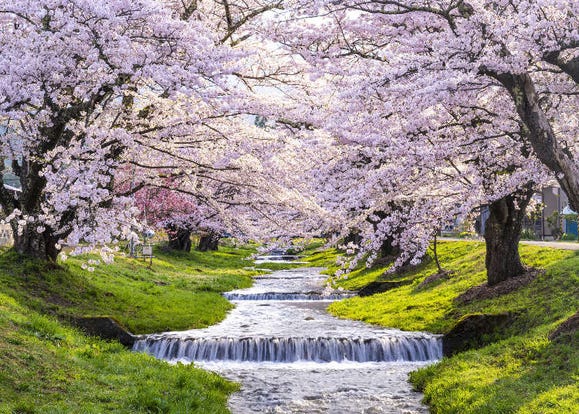
10 Dreamy Places in Fukushima to See the Cherry Blossoms
-
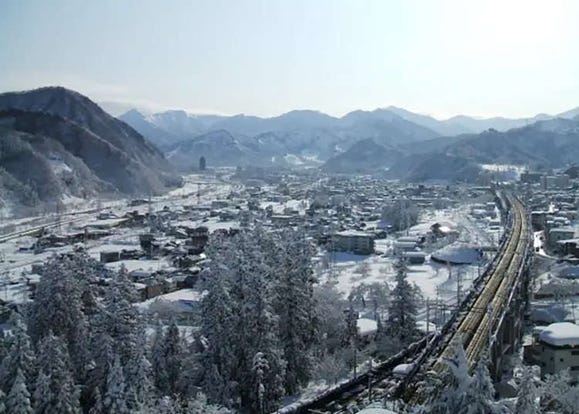
Takahan Ryokan: Enjoy Spectacular Hot Spring Views at Yuzawa's Premier Traditional Inn!
-

Sendai Umino-Mori Aquarium: Inside Northeast Japan's Largest Aqua Attraction
-
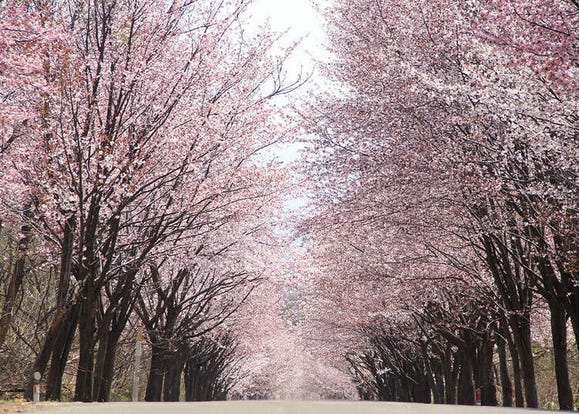
20km Cherry Blossom Tunnel! Japan’s Mt. Iwaki Has “The World's Longest Cherry-Lined Road”
-

Because Tokyo is Too Crowded: 15 Cherry Blossom Spots in Tohoku, Northern Japan (Blooming: Late April 2024)
-
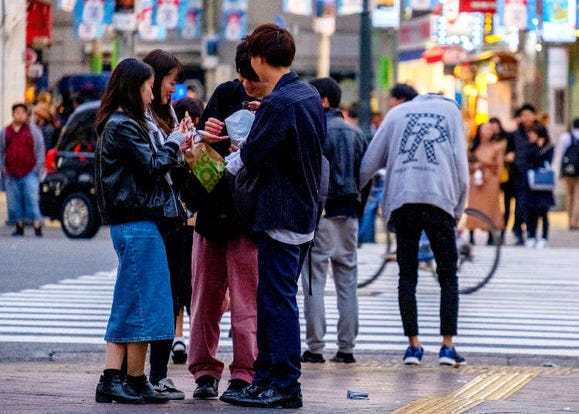
8 Unfamiliar (But Totally Normal) Customs in Japan!
-
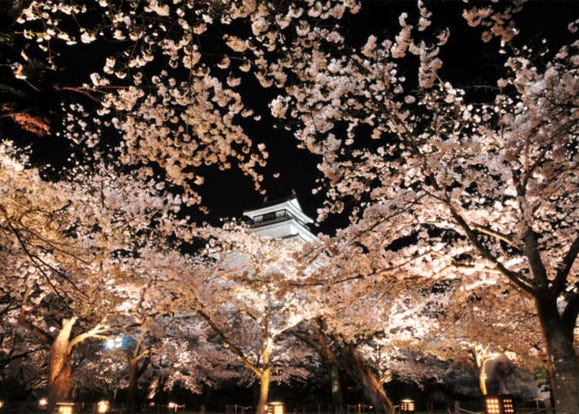
10 Cherry Blossom Festivals to Enjoy in Japan's Tohoku Region in 2024













